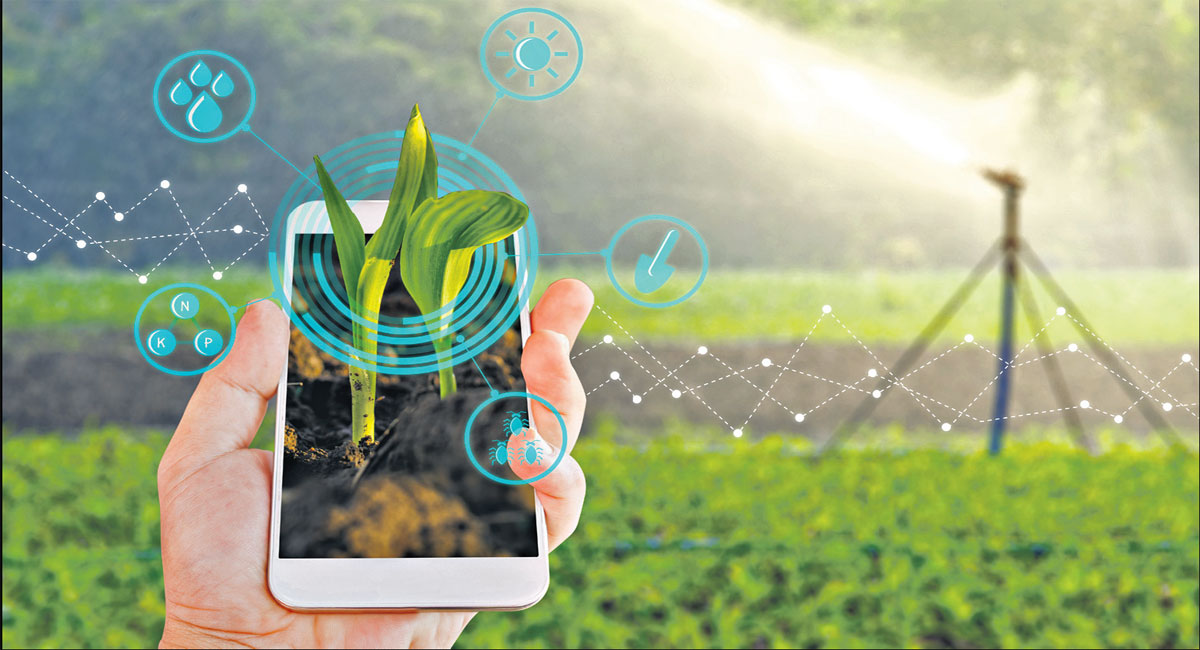Involving the use of GPS technology, sensors, and drones to collect detailed information about soil conditions, crop health, and weather patterns
 KRC TIMES Desk
KRC TIMES Desk

Digital agriculture refers to the integration of advanced technologies and digital tools into traditional farming practices to enhance productivity, sustainability, and efficiency in food production. This innovative approach leverages a variety of technologies such as precision farming, data analytics, Internet of Things (IoT), artificial intelligence (AI), and robotics to transform agriculture into a more data-driven and technologically sophisticated industry.
Precision farming is a key component of digital agriculture, involving the use of GPS technology, sensors, and drones to collect detailed information about soil conditions, crop health, and weather patterns.
This data is then analysed to make informed decisions on resource management, optimizing the use of water, fertilizers, and pesticides. By precisely tailoring inputs to specific areas of a field, farmers can reduce waste and improve overall efficiency.
The Internet of Things plays a crucial role in digital agriculture by connecting various devices and sensors on the farm. Smart sensors placed in the field continuously monitor and collect realtime data on soil moisture, temperature, and crop growth. This information is transmitted to a central system, allowing farmers to monitor and manage their crops remotely.
IoT also enables the automation of certain tasks, such as irrigation and pest control, leading to more sustainable farming practices. Artificial intelligence is another key element in digital agriculture. Machine learning algorithms analyse vast amounts of data to identify patterns and make predictions.
Farmers can use AI-powered tools to optimize planting schedules, predict disease outbreaks, and even assess the quality of crops. This helps farmers make data-driven decisions that enhance productivity and reduce risks. Robotics is making significant contributions to digital agriculture by automating labour-intensive tasks.
Autonomous tractors, drones, and robotic harvesters can perform various functions such as planting, spraying, and harvesting crops. This not only reduces the workload on farmers but also ensures precision and efficiency in operations. Robotics can also address labour shortages in agriculture, especially in regions where there is a declining workforce.

Data analytics is a crucial aspect of digital agriculture, helping farmers gain insights from large datasets. By analysing historical and real-time data, farmers can identify trends, optimize resource allocation, and make informed decisions.
This data-driven approach enables continuous improvement in farming practices, leading to higher yields and profitability. The adoption of digital agriculture has the potential to address several challenges facing the agricultural sector, including the need to feed a growing global population, climate change impacts, and resource constraints.
By harnessing the power of digital, farmers can enhance their decision-making processes, optimize resource use, and improve overall sustainability. Additionally, digital agriculture promotes the integration of environmentally friendly practices, reducing the environmental footprint of farming activities.
Introduction – The term digital agriculture refers to the use of computers and other electronic devices in farming and other agricultural endeavours. Digital agriculture enables farmers and other stakeholders in the agriculture value chain to increase food production using advanced technologies incorporated into a single system.
Digital agriculture is a database that contains various information about cultivation, from soil conditions to market assessments, as well as optimal decision operations that aid in making the best choices throughout several agricultural production and distribution processes.
A digital agriculture system is a crucial tool for managing agricultural risks. It can assess climate change risks, create a revenue protection policy, and produce a soil quality management program.
Importance of Digital Agriculture– Farmers rely on cutting-edge technologies to collect and analyse data from their farms to maximize their harvests.
Digital agricultural technologies can monitor factors such as moisture, nutrient trends, soil composition, and wind patterns of arable land. The digital agriculture system collects data accurately (such as weather information) using external sources. The combined data is examined and interpreted to help the farmer make better decisions.
Robotics and advanced equipment quickly put these decisions into action with greater accuracy, and farmers can receive real-time feedback on the effects of their actions. Accurate weather predictions, yield mapping, variable-rate applications (of water, herbicides, and fertilizers), and GPS guiding systems are all components of digital agriculture.
GIS & Remote Sensing Techniques in Agriculture– A geographic information system (GIS) is a computer-based tool for capturing, storing, checking, and displaying data related to positions on Earth’s surface. It was used back in 1854 (without computers) to map a disease outbreak in the City of London.
The first Geographical Information System (GIS) was developed in the early 1960s by the Canadians to store geospatial data and produce maps for the Canadian Land Inventory. This data provided an indication of the land’s capability to support agriculture, wildlife, forestry and recreational activities.
Over the past few decades, Remote sensing and GIS has grown exponentially in many sectors of visualization, monitoring, management and potential development. Remote sensing and GIS technology enable agencies to get reliable information of natural and manmade features and interpret appropriately phenomenon occurring over the earth’s surface without making any physical contact.
Since the World GIS day has already been celebrated on November 2021, it is a great time to appreciate just how much this technology has influenced the productivity of farmers, agriculture specialists and environmentalists alike.
Therefore, GIS has become indispensable for mapping agricultural activities. The Agricultural Geographic Information System Laboratory (AGIS) developed at the University of California, Davis, is deeply involved in the advancement of the agriculture/GIS relationship.
This AGIS lab researches the effects a watershed area has on soil nutrients, the use and movement of pesticides on crops, mapping water use and availability in rural agricultural areas as well as cities, tracking potential plant diseases, and expanding the GIS capabilities to cover the entire state.
In addition to expanding the potential uses of GIS, the AGIS Laboratory is dedicated to disseminating the information they gather to local farmers, wineries, and city officials to help promote healthy change in behaviours that affect the agricultural outputs of California.
With the permeation of technology in the global culture, it is possible that in a few years GIS could be available to rural farmers in the developing world to help them grow better crops, feed their families, and produce enough food to ship to neighbouring areas.
Farmers in severe weather prone areas (like flood plains or drought zones) would be able to predict what this weather could do to crops, could move fields to better geographic locations, and know how to irrigate based on local water resources and weather patterns. The world food crisis could be alleviated by the use of GIS.



